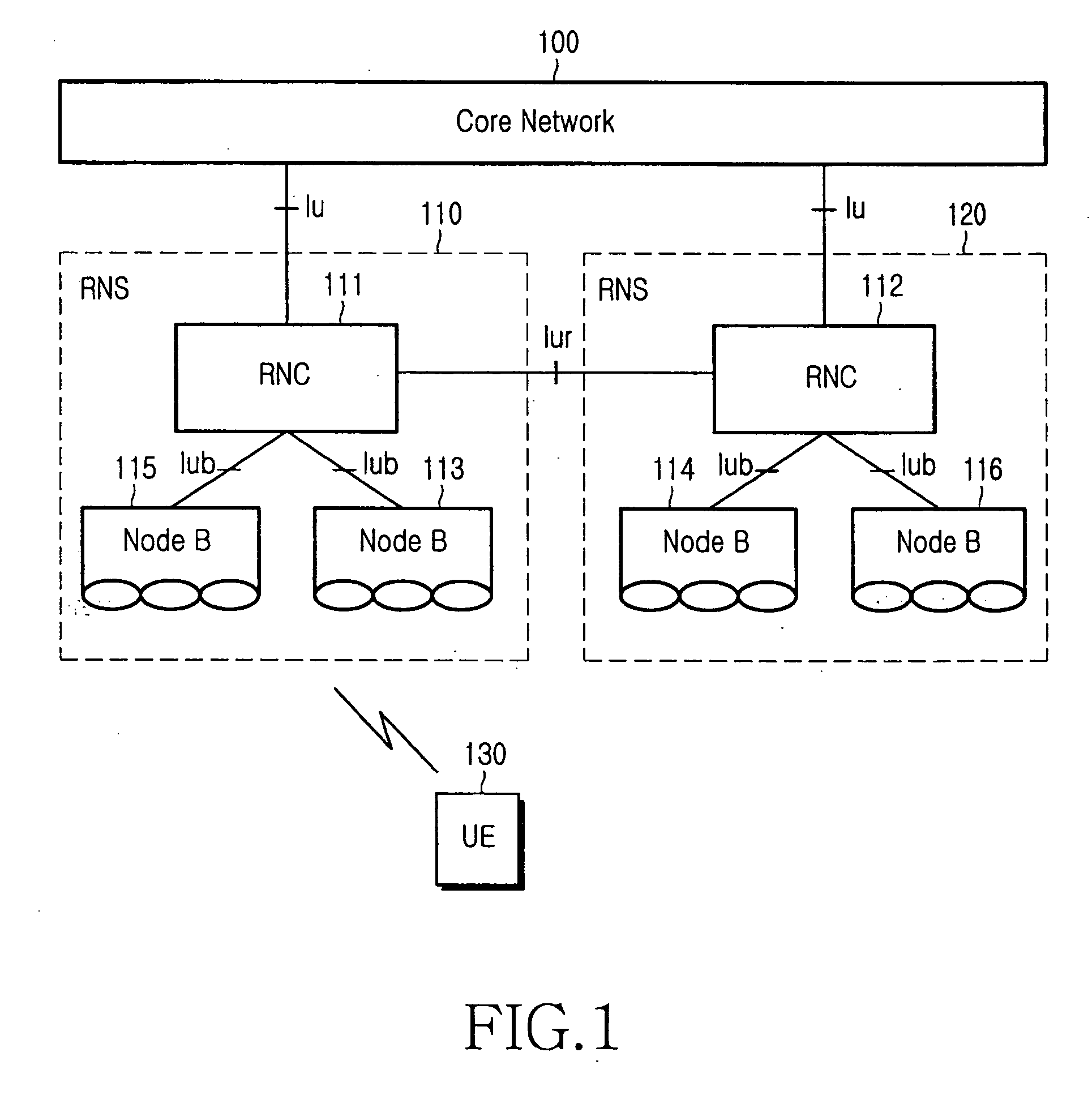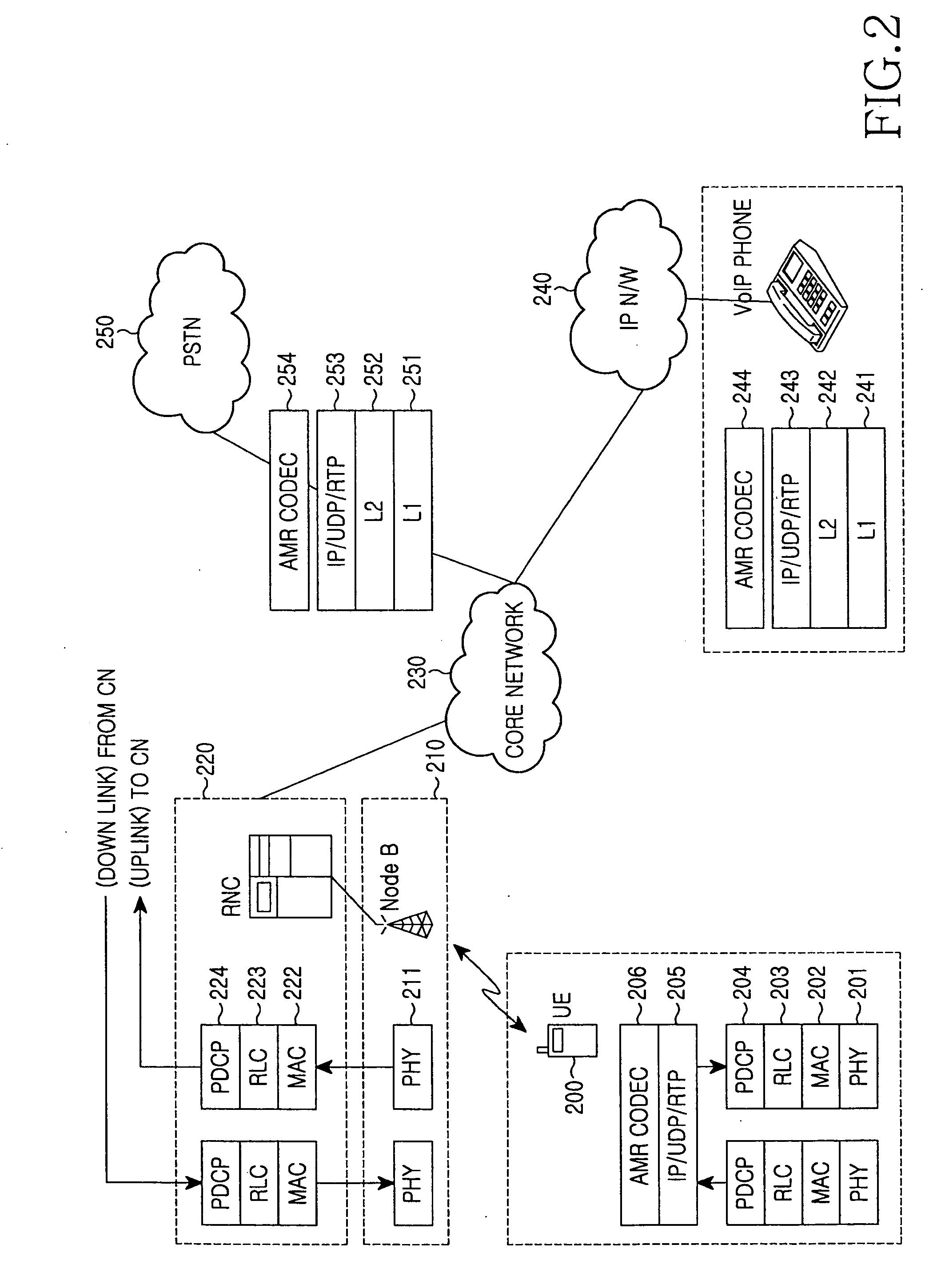Method and apparatus for supporting voice service through radio channel in mobile telecommunication system
a mobile communication system and packet network technology, applied in data switching networks, frequency-division multiplexes, instruments, etc., can solve the problems of reducing the efficiency of radio resource utility, difficult to obtain a benefit according to an adaptive codec mode, etc., and achieve the effect of efficient processing of voice packets through packet networks
- Summary
- Abstract
- Description
- Claims
- Application Information
AI Technical Summary
Benefits of technology
Problems solved by technology
Method used
Image
Examples
first exemplary embodiment
of the Present Invention
[0070]FIG. 4 is a signal flowchart of an overall network setting the size of packet data according to the first embodiment of the present invention. The network comprises at least a user equipment (UE) 405, a radio network controller (RNC) 410 and a GPRS supporting node (SGSN) 415.
[0071] In step 420, the terminal 405 exchanges a VoIP session establishing message with a call controlling device (not shown) of the core network (SGSN) 415. In this case, the VoIP session may be established through a session initiation protocol (SIP). Herein, the call controlling device may be an SIP server.
[0072] The terminal 405 exchanges a predetermined message with the SIP server, thereby establishing the VoIP session. The messages for establishing the VoIP session include session description protocol (SDP) parameters, and the parameters may be parameters relating to call characteristics such as a requested bandwidth and a codec type.
[0073] In step 425, the terminal 405 reco...
second exemplary embodiment
of the Present Invention
[0116] According to the second embodiment of the present invention, a method is provided for reducing unnecessary padding through signal exchange between a terminal and a SGSN. The second embodiment of the present invention is designed in consideration of the fact that a typical 328-bit RLC PDU is efficiently employed for a 12.2 kbps AMR codec mode, but inefficiently employed for another AMR codec mode.
[0117] According to the second embodiment of the present invention, an SGSN may order a terminal to fix an AMR codec mode at a rate of 12.2 kbps or not to operate at multi-rates. Through the order, it is possible to remove a side effect derived from the change of a codec mode.
[0118]FIG. 9 is a signal flowchart of an overall network setting the size of packet data according to the second embodiment of the present invention. The network comprises at least a user equipment (UE) 905, a radio network controller (RNC) 910 and a GPRS supporting node (SGSN) 915.
[011...
third exemplary embodiment
of the Present Invention
[0126] A notable characteristic of the AMR codec is that it can make voice data with a variable size according to the environment of the radio channel. This is called an ‘AMR mode’ in the AMR codec, and the AMR codec has eight AMR modes as defined below in Table 1.
TABLE 1AMR codecAMR packet sizeAMR packet sizemodesPayload sizesin BE modein OA modeSID 39 bits 56 bits 56 bits4.75 kbps 95 bits112 bits112 bits5.15 kbps103 bits120 bits120 bits5.90 kbps118 bits128 bits136 bits6.70 kbps134 bits144 bits152 bits7.40 kbps148 bits160 bits168 bits7.95 kbps159 bits176 bits176 bits10.2 kbps204 bits216 bits224 bits12.2 kbps244 bits256 bits264 bits
[0127] In Table 1, a silent description (SID) represents a packet generated in a silent period.
[0128] An AMR packet generated according to modes has a variety of sizes of between 112 bits to 224 bits.
[0129] The AMR packet denotes data 507 generated from the codec 505 shown in FIG. 5, and includes a payload header and a payload....
PUM
 Login to View More
Login to View More Abstract
Description
Claims
Application Information
 Login to View More
Login to View More - R&D
- Intellectual Property
- Life Sciences
- Materials
- Tech Scout
- Unparalleled Data Quality
- Higher Quality Content
- 60% Fewer Hallucinations
Browse by: Latest US Patents, China's latest patents, Technical Efficacy Thesaurus, Application Domain, Technology Topic, Popular Technical Reports.
© 2025 PatSnap. All rights reserved.Legal|Privacy policy|Modern Slavery Act Transparency Statement|Sitemap|About US| Contact US: help@patsnap.com



